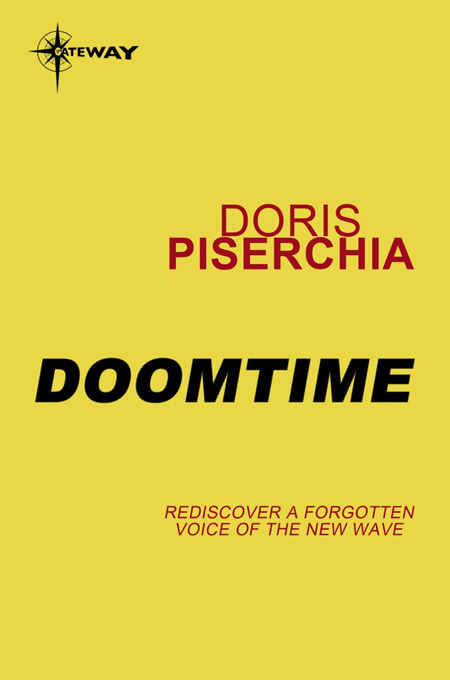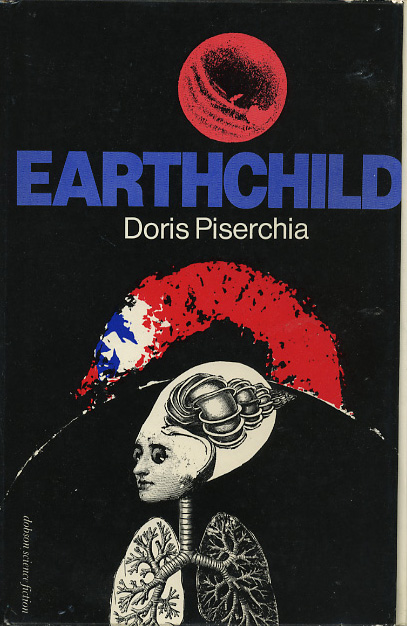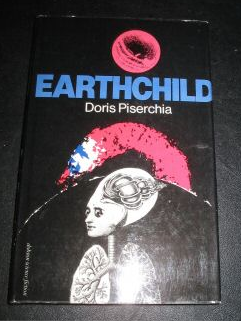The following posts include (1) "footnotes" for The Doris Piserchia Website (link at left), (2) texts-in-process that will eventually appear there, (3) texts from other websites, and (we hope) (4) stimulating discussion threads. The picture to the left is the back cover of The Spinner (book club edition), depicting a citizen of Eastland "hanging out" while Ekler the cop and Rune the idiot-superman look on.
View current page
...more recent posts
John Clute's entry on Doris Piserchia in the Encyclopedia of Science Fiction is online and has been tweaked slightly from its original wording in print. Besides the addition of distracting links to other tagged content (yes, we know what "Aliens" are) there is a slight harshening of the assessment of Piserchia's later work.
The last sentence now reads:
In her self-consciousness, and in the sense she conveys that landscape drowns action (rather than vice versa), Piserchia seemed for a period very much a member of the US New Wave; but her later works lacked some the bounteous energy of the earlier work, she stopped publishing in 1983, and there was no further development in a career that had flourished, absorbingly, for only a decade.
Whereas it used to read:
In her self-consciousness, and in the sense she conveys that landscape drowns action (rather than vice versa), DP seemed for a period very much a member of the U. S. new wave; but she has not published since 1983, and the course of her further development cannot properly be guessed.
At the time of the original entry Clute didn't know if Piserchia would write again and possibly didn't want to come down too hard on the late work. At the time of re-writing he knew it was over and decided to assess which phase had more "bounteous energy." It's almost as if he counted the cessation of writing against her, though, creating a "flame sputtering to darkness" narrative. I don't agree with that: The Spinner, Doomtime, and the Selby books are among her best, and they all came at the end.
Having recently re-read Doomtime and Earthchild, I see what Clute means about the work's coyness (an adjective he uses in both entries). It's not so much cuteness as a lack of seriousness about telling a real story. Sometimes the narratives lose credibility as say, bickering characters have a conversation that seems more like the author talking to herself because, what the hell, no one is reading this. Philip K Dick did that, too, and when it works it's subversive. At any rate, I recall such passages in all phases of Piserchia's writing (for example, conversations with Sheen in A Billion Days of Earth), not just the late novels.
An Amazon review of Doomtime by Mithridates VI of Pontus:
Welcome to the fevered fungal/vegetable nightmares and uncanny vistas of Doris Piserchia. A virtually forgotten science fiction author -- her books are all long out of print -- who deserves to be read and remembered.
Doomtime (1981) is by no means a classic (and not her best work) but should be read for its sheer imaginative and haunting power. Despite the fact that the pacing is poor, the characters undeveloped, and Piserchia's prose often falters, the world she creates is memorable and disturbing (sadly, the volume is "graced" with some atrocious cover art, well, besides that weird bug thing -- a Piserchia staple).
The book opens with Creed surviving an assassination attempt but with the assassin (now missing a section of his brain) attached to Creed's head. How did this happen? Well, Creed's people produce most of their food from a gigantic brass bowl (a technology developed in the distant past) filled with proto-flesh (which gurgles out into various molds creating chickens, etc). The assassin attempted to push Creed into the pool (which Creed cleans for a living) but bubbles of the proto-flesh melded the two together. Perhaps this gives you an idea of Piserchia's imagination?
Creed eventually discovers a series of bizarre occurrences, strange molds near the brass bowl produce pinkish creatures which spin like tornadoes and kill people, people disappear into trees only to reappear, and others hunt him with bows and arrows. He realizes that one can meld with the trees which are suddenly growing prolifically near the city. The green ones are called Tedron and the reddish ones Krake. These trees -- linked to each other by roots and eventually to gigantic Everest sized trees of each color -- are fighting a war between each other. By dipping (melding) into a tree, humans becomes addicted and subtle commands implanted into their minds -- the humans become pawns in their war.
Creed sets off to rectify the situation and meets fungus creatures which meld with humans, strange fungus pools that unravel people's psyches, humans sucked dry by Tedron and Krake, humans mutated beyond recognition by the trees, humans turning into trees, fuzzy smallish fungus which grow around peoples' necks, addicted humans stuck in hibernating trees desperate to meld.... Eventually Creed comes upon the central Tedron and Krake -- separated from each other by a mountain range -- and an unusual secret in their upper limbs.
The most disturbing element of this novel is how little the humans have control over their situation. Entire groups of humans are transformed by these trees -- humans are in no way the superior lifeforms. Piserchia is the master at showing instead of telling -- often in an offhand matter of fact way which intensifies the dread and unease. This has to be one of the more unusual and disturbing worlds I've ever read about.
Sadly, Doomtime's structure is a letdown. The entire middle section drags as characters endlessly explore in groups, get separated, manipulated by the trees, betray their companions, feel sorry for them, escape, get separated, get tree manipulated some more, and go out and explore as if nothing happened. Piserchia clearly did not know how to finish the novel (or perhaps reach her page limit). Also, Piserchia writes using clustered vignettes. Thus, an individual narrative thread rarely goes beyond a page or two. This style is really frustrating.
That said, the world itself with its bizarre technology, creepy female fungus creatures, twirling pink creatures, proto-flesh weapons, tree dipping, fungus melding activities, human transforming, and of course the weather creating world destroying trees, is staggeringly inventive.

Very excited to see that Doris Piserchia's novels are being published as e-books by Orion Publishing's Gateway imprint, out of the UK. Congratulations to the author for this wonderful development. (Half the essays on this site lament her being out of print -- now we can just lament that she was out of print for 30 years.)
Published so far: Doomtime, Earthchild, Earth in Twilight, The Dimensioneers, Spaceling, and The Spinner. More titles are coming.
I like the sparse cover designs and the retro "Gateway" logo. What, no bug eyed monsters?
Update: Evidently sparse covers are a trend in print as well as e-books, for literary classics as well as genre reprints. Likely the main reason is cost, because you don't have to pay an artist to make an original cover illustration. With "back catalog" materials you aren't so worried about attracting an initial readership with an exciting cover. Still it will be harder for them to build a new audience for Piserchia that way. I first read her because of an intriguing cover in a supermarket (Doomtime's as a matter of fact.)
Update 2: Piserchia's author page at Gateway. Am reading the Doomtime e-book now; the page design is clean and am not finding typos, except for: (i) an unfortunate "Peserchia" in the bio at the end of the book and (ii) misspelling of Blood County as Blood Country in the author book list, also at the end (the latter error is also in John Clute's sf encyclopedia entry on Piserchia). These goofs appear to have occurred in all the books. The Peserchia typo may have originated with Amazon, which uses her Wikipedia entry verbatim, adding that nit.
Update 3: Minor typos: a couple of stray apostrophes, "wag" instead of "way" (the same error appears on p. 40 of the DAW paperback); "Galley" for "valley" (correct in the DAW edition, p. 79).

An even clearer version of the Earthchild cover--thanks, twice, AR.

A British edition of Earthchild to add to the cover gallery. Thanks to AR.
